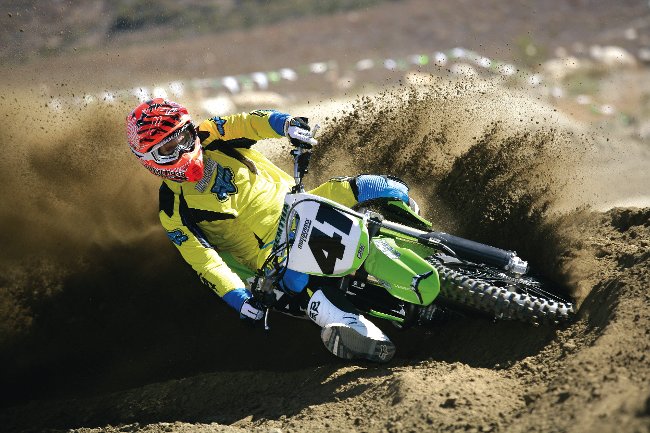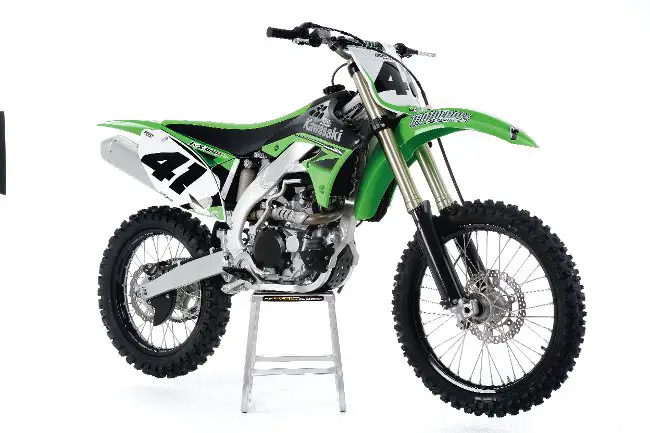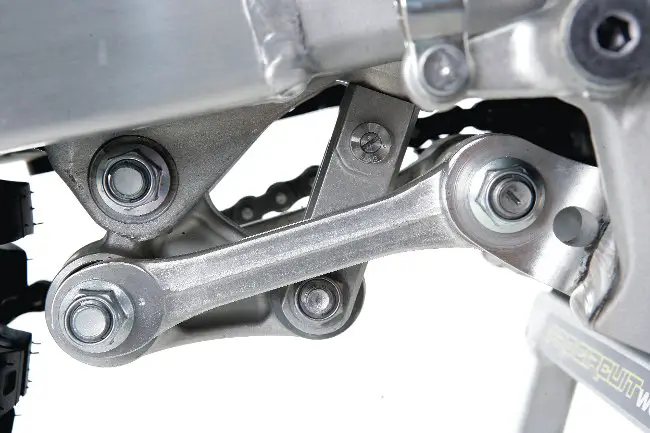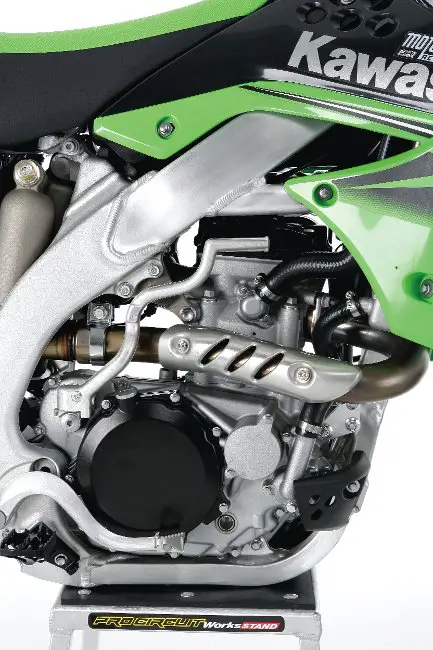REAL TESTS! 2010 MXA RACE TEST OF THE KAWASAKI KX450F:

Q: FIRST AND FOREMOST, IS THE 2010 KX450F BETTER THAN THE 2009 KX450F?
A: Yes. It should be noted, however, that not every aspect of the 2010 KX450F is improved over last year. If improvements to the 2010 were viewed as a batting average, Kawasaki would be hitting about .500.
Q: WHAT DID KAWASAKI CHANGE ON THE 2010 KX450F?
A: For what seems like the fourth year in a row, Kawasaki’s engineers redesigned virtually every part of the KX450F. Although it isn’t a totally new bike, as it was in 2009, there are very few major components on the bike that haven’t seen serious mods (and that includes the engine, frame, suspension and plastic).
Q: WHAT ARE THE MAJOR ENGINE CHANGES FOR 2010?
A: To make the technical data easier to digest, we are going to list the changes and what Kawasaki hoped to achieve by redesigning the part.

Piston. The 2010 piston is essentially a copy of the Pro Circuit race piston. Previous KX450F pistons had the irritating habit of breaking in half. To stop this, the 2010 KX450F piston uses a “bridge-box bottom” design. What does that mean? The reinforcing ribs in the underside of the KX450F piston now form a box-shape. Additionally, the piston is seven grams lighter, has a 6mm shorter skirt and shorter piston pin (from 50.3mm to 45.7mm).
Cylinder. The cylinder skirt has been increased in thickness by 1.3mm and it inserts 10mm farther down into a reinforced set of engine cases. Obviously, Kawasaki felt that some of the piston breakage problems were related to both piston and cylinder rock.
Crankshaft. The 2010 KX450F crank gets more rotational inertia by moving the mass to an offset position (from 47.2 kg/cm2 to 48.2 kg/cm2).
Intake cam. Intake valve timing has been moved forward two degrees with a repositioning of the camshaft sprocket. Advancing the cam timing should increase bottom-end power.
Clutch. A new pressure plate and friction plates increase durability and feel. The new pressure plate flows more oil, while the new friction plates have 75 percent more friction material (the segmented pads were replaced with a 100-percent circular pad with notches).
Exhaust system. The head pipe is 40mm shorter than in 2009. It is stainless steel instead of titanium. It wraps tighter around the engine. The shorter head pipe should increase mid-to-top power.

Personality: The KX450F’s defining features are that it is tall, long and wide. It wants to turn, but gives riders the sensation that it wants to stand up at the apex. This is not comforting. The front tire wants to turn, but the rear wheel won’t follow.
Q: WHAT DO ALL OF THESE 2010 ENGINE CHANGES ADD UP TO?
A: Amazingly enough, the 2010 KX450F engine is better than the awesome 2009 engine. Thanks to some mapping changes, a new exhaust pipe, lighter piston and new cam timing, the 2010 engine hits harder and pulls farther. The new engine is 1.4 horsepower more powerful than last year’s KX450F engine. Even better, the increased rotational inertia of the crank, bridge-box piston and bigger radiators make the KX450F more durable, easier to use and less prone to the troubles that have plagued this engine since 2006.
Q: HOW FAST IS THE 2010 KX450F?
A: This is a great motocross engine. Did we say “great”? We mean fabulous! It is strong off the bottom without being jerky. It is usable in the middle with a strong, broad and steady pull. While it isn’t awesome over the top, it is better than the other three fuel-injected bikes in its class. The 2010 KX450F makes competitive power to 9000 rpm. It makes the most peak horsepower of any Japanese 450 and has the best low-to-mid power of any 2010 450.
For riders who like potent low-to-mid engines (that pull across the middle), the KX450F powerband is a logical choice. And, for riders who want the best race engine possible, this is also the logical choice.
Q: HOW DOES THE 2010 KX450F RUN ON THE DYNO?
A: The 2010 Kawasaki KX450F romps the 2009 KX450F on the dyno. The new engine makes a minimum of one horsepower more at every spot on the dyno (from 5300 rpm on up). Peak horsepower was up from 52.33 in 2009 to 53.76 horsepower at 8900 rpm. That is a significant improvement.
The curves are identical on the 2009 and 2010, but the horses are up. For comparison purposes, the KX450F makes 53.76 horsepower, the CRF450 makes 50.90 and the YZ450F pumps out 52.63. The king of peak horsepower, the KTM 450SXF, produces 53.92 horsepower.
Q: IS THERE ANYTHING NOT TO LIKE ABOUT THE 2010 KX450F ENGINE?
A: Yes. The gearbox is still too gappy, but the massive horsepower has a way of covering up some of the tranny’s major flaws. We used to gear it down, but the extra ponies mean that we don’t have to cover the gap with gearing fixes anymore.
Q: HOW DOES KAWASAKI’S FUEL INJECTION COMPARE TO THE CRF450 AND RM-Z450’S EFI?
A: Kawasaki has the best fuel-injected 450cc engine. For some reason, Suzuki, Yamaha and Honda have struggled with getting usable top-end (as in power above 9000 rpm). Not Kawasaki. Where the CRF, YZ-F and RM-Z go flat (or worse, sign off), the KX450F keeps right on pulling. Only the KTM 450SXF makes more peak horsepower or pulls farther on top.
Q: WHAT DID KAWASAKI DO TO THE 2010 KX450F CHASSIS?

Rising rate: The 2010 KX450F link is the Pro Circuit link.
For 2010, the changes are a mere shadow of the 2009 mods. Here is the short list.
Steering stem. The steering stem has been reduced from 24mm to 23mm (to reduce rigidity).
Swingarm. The swingarm has thinner walls, decreased rib height and revised cross-section width.
Q: HOW DOES THE 2010 KX450F HANDLE?
A: It handles the same as it did last year. Even with Kawasaki’s attempts to feed more flex into the KX450F chassis, the basic numbers (wheelbase, seat height, fork offset, head angle and front center) are all the same. It’s not that the MXA wrecking crew hates the KX450F chassis, it’s just that we know that it can be better with a few aftermarket changes.
Kawasaki’s engineers need to commit to a program that includes a steeper head angle, shorter wheel base, lower seat height, better ergonomic riding position and less fork offset. Until then, the KX450F will maintain the same cranky character that its brethren have displayed since 2006.
Q: WHAT IS THE DEFINING CHARACTERISTIC OF THE KX450F CHASSIS?
A: The KX450F’s defining feature is that it is the “20th Century Unlimited” of motocross bikes?a big runaway train of a bike. It is tall, long and wide. It wants to turn, but hesitates in the center of corners and twitches momentarily. Riders get the sensation that the bike wants to stand up at the apex. This is not comforting. The front tries to turn, but the rear wheel won’t follow.
Q: HOW IS THE 2010 KX450F SUSPENSION?
A: As much as we have browbeaten Kawasaki’s engineers about the flawed chassis, we are impressed by the steps that they have taken to fix the suspension setup. Historically, the KX450F has wallowed in the rear and been alternately too soft or too stiff in the front.
Fixing the 2006 through 2009 KX450F suspension required considerable work to get the balance right. Thankfully, Kawasaki made some major strides towards bringing the front and rear into sync for 2010.
Q: WHAT WERE OUR BEST FORK SETTINGS?
A: Kawasaki installed stiffer fork springs (from 0.46 to 0.48 kg/mm), smoothed out the damping and Kashima-coated the inner tubes. The overall fork setup on the 48mm Kayaba AOSS (Air Oil Separate System) forks was vastly improved, although skewed to the firm side.
Spring rate: 0.48 kg/mm
Oil height: 335cc
Compression: 10 clicks out
Rebound: 12 clicks out (10 out stock)
Fork leg height: 10mm up
Notes: The chassis is very sensitive to fork height. As a rule, we ran the forks up in the clamps until we got oversteer, then slid them down two millimeters.

Iron man: The 2010 KX450F engine is more durable.
Q: WHAT WAS OUR BEST SHOCK SETTING?
A: In an effort to end the bike’s reputation for wallowing, Kawasaki’s engineers built an all-new, rising-rate linkage (bellcrank and link arms) and upped the shock spring rate from 5.3 to 5.5 kg/mm.
For hardcore racing, these are MXA‘s recommended 2010 KX450F shock settings.
Spring rate: 5.5 kg/mm
Race sag: 100mm
Hi-compression: 1-1/2 turns out
Lo-compression: 10 clicks out
Rebound: 10 clicks out
Notes: The 2010 KX450F is very sensitive to balance between the front and rear. The new shock linkage is a close copy of the Pro Circuit link.
Q: DID KAWASAKI PAY ATTENTION TO CONSUMER COMPLAINTS?
A: Yes and no.
On the yes list: Last year, we whined about broken pistons (they have a stronger piston for 2010). We hated last year’s Dunlop D742 front tire (they switched to Bridgestone for 2010). In 2009, we boiled the engine in any moto over 15 minutes (they increased the size and thickness of the radiators for 2010). The 2009 clutch was on the verge of slipping every time we used it (the 2010 pad material encompasses 75-percent more surface area). We hated how loud the 2009 KX450F was (this year, it’s quieter on the decibel scale). Last year, the KX450F wallowed in the rear and we ran a 135mm Pro Circuit link to lower the rear and stop the wallow (this year, Kawasaki copied Pro Circuit’s 135mm link.)
On the no list: The 2010 gearbox is still too gappy (horsepower can only compensate so much). We still lose the graphics in the first hour of riding. The chain ate the chain guide in a couple of races (order a TM Designworks chain guide today). The 2010 KX450F is still sized for Paul Bunyon. We broke the radiator wings in the first hour.
Q: WHAT DID WE HATE?
A: The hate list:
(1) Shifting. This isn’t an A+ shifter. It’s more like a B+. That means you are going to have to be careful when shifting under a load.
(2) Gearbox. It’s really the old four-speed gearbox with a fifth gear tacked on. It is wide ratio.
(3) Plastic. The front fender has been beefed up, but the rest of the plastic parts are flimsy.
(4) Rear brake pedal. If you want to run the rear brake pedal low, you have to hacksaw off some of the plunger’s threaded rod.
(5) Clutch. It’s better, thanks to new friction plates, but it needs stiffer clutch springs to live.
(6) Weight. This thing is a brick. It weighs ten pounds more than a CRF450. Shockingly, it weighs more than the electric-start KTM 450SXF.
Q: WHAT DID WE LIKE?
A: The like list:
(1) Powerband. Love this powerband. It is the best engine made.
(2) Sound. Last year, the KX450F made a very obnoxious 99 dB. For some reason, and we can’t find any extra effort on Kawasaki’s part to make it quieter, the 2010 model produced 96.5 dB. We would be remiss if we didn’t tell you that the KX450F sounds a lot louder than 96 dB in action, but we sound tested it several times just to make sure.
(3) Jetting. There is no jetting.
Q: WHAT DO WE REALLY THINK?
A: To tell the truth, the 2010 KX450F is all about its engine. This luxurious powerband overshadows everything on the bike?the good and the bad.






Comments are closed.